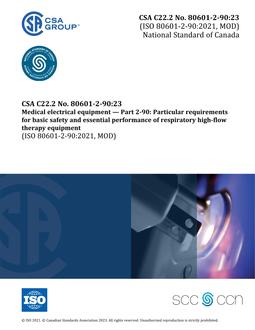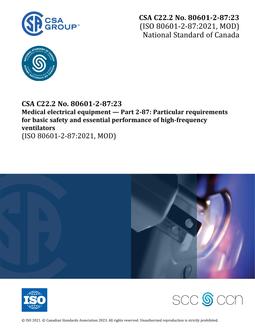
CSA C22.2 NO. 80601-2-90:23
CSA Preface
This is the first edition of CSA C22.2 No. 80601-2-90, Medical electrical equipment — Part 2-90: Particular requirements for basic safety and essential performance of respiratory high-flow therapy equipment, which is an adoption, with Canadian deviations, of the identically titled ISO (International Organization for Standardization) Standard 80601-2-90 (first edition, 2021-08). It is one in a series of Standards issued by CSA Group under Part II of the Canadian Electrical Code. For brevity, this Standard will be referred to as “CSA C22.2 No. 80601-2-90” throughout. This Standard is intended to be used in conjunction with CAN/CSA-C22.2 No. 60601-1:14, Medical electrical equipment — Part 1: General requirements for basic safety and essential performance (adopted IEC Standard 60601-1:2005, edition 3.2, with Canadian deviations). This Standard is considered suitable for use for conformity assessment within the stated scope of the Standard. This Standard was reviewed for Canadian adoption by the CSA Technical Committee on Consumer and Commercial Products, under the jurisdiction of the CSA Strategic Steering Committee on Requirements for Electrical Safety, and has been formally approved by the Technical Committee. Due to the medical content of this Standard, it was also approved by the CSA Technical Committee on Application of Electricity in Health Care, under the jurisdiction of the CSA Strategic Steering Committee on Health and Well-being. This Standard has been developed in compliance with Standards Council of Canada requirements for National Standards of Canada. It has been published as a National Standard of Canada by CSA Group.
Scope and object
Clause 1 of IEC 60601-1:2005+AMD1:2012+AMD2:2020 applies, except as follows:
NOTE The general standard is IEC 60601-1:2005+AMD1:2012+AMD2:2020.
201.1.1 *Scope Replacement: This document applies to the basic safety and essential performance of respiratory high-flow therapy equipment, as defined in 201.3.220, hereafter also referred to as ME equipment or ME system, in combination with its accessories: — intended for use with patients who can breathe spontaneously; and — intended for patients who would benefit from improved alveolar gas exchange; and who would benefit from receiving high-flow humidified respiratory gases, which can include a patient whose upper airway is bypassed.
EXAMPLE 1 Patients with Type 1 Respiratory Failure who exhibit a reduction in arterial blood oxygenation.
EXAMPLE 2 Patients who would benefit from reduced work of breathing, as needed in Type 2 Respiratory Failure, where arterial carbon dioxide is high.
EXAMPLE 3 Patients requiring humidification to improve mucociliary clearance. Respiratory high-flow therapy equipment can be intended for use in the home healthcare environment or intended for use in professional healthcare facilities.
NOTE 1 In the home healthcare environment, the supply mains is often not reliable. Respiratory high-flow therapy equipment can be: — fully integrated ME equipment; or — a combination of separate items forming a ME system. This standard also applies to other types of respiratory equipment when that equipment includes a respiratory high-flow therapy mode.
NOTE 2 This standard and ISO 80601-2-12[14] are applicable to a critical care ventilator with a high-flow therapy mode. Respiratory high-flow therapy equipment can be transit-operable. This document is also applicable to those accessories intended by their manufacturer to be connected to the respiratory high-flow therapy equipment, where the characteristics of those accessories can affect the basic safety or essential performance of the respiratory high-flow therapy equipment.
EXAMPLE 4 Breathing sets, connectors, humidifier, breathing system filter, external electrical power source, distributed alarm system, high-flow nasal cannula, tracheal tube, tracheostomy tube, face mask and supra-laryngeal airway. If a clause or subclause is specifically intended to be applicable to ME equipment only, or to ME systems only, the title and content of that clause or subclause will say so. If that is not the case, the clause or subclause applies both to ME equipment and to ME systems, as relevant. Hazards inherent in the intended physiological function of ME equipment or ME systems within the scope of this document are not covered by specific requirements in this document except in the general standard, 7.2.13 and 8.4.1.
NOTE 3 Additional information can be found in the general standard, 4.2. This document does not specify the requirements for: — ventilators or accessories for ventilator-dependent patients intended for critical care applications, which are given in ISO 80601-2-12[14]; — ventilators or accessories intended for anaesthetic applications, which are given in ISO 80601-2-13[15]; — ventilators or accessories intended for the emergency medical services environment, which are given in ISO 80601-2-84[20]; — ventilators or accessories intended for ventilator-dependent patients in the home healthcare environment, which are given in ISO 80601-2-72 [17]; — ventilatory support equipment or accessories intended for patients with ventilatory impairment, which are given in ISO 80601-2-79[18]; — ventilatory support equipment or accessories intended for patients with ventilatory insufficiency, which are given in ISO 80601-2-80[19]; — sleep apnoea therapy ME equipment, which are given in ISO 80601-2-70 [16]; — continuous positive airway pressure (CPAP) ME equipment; — high-frequency jet ventilators (HFJVs)[31], which are given in ISO 80601-2-87[21]; — gas mixers for medical use, which are given in ISO 11195[9]; — flowmeters, which are given in ISO 15002[11]; — high-frequency oscillatory ventilators (HFOVs), which are given in ISO 80601-2-87[21]; and — cuirass or “iron-lung” ventilation equipment. This document is a particular standard in the IEC 60601 series, the IEC 80601 series and the ISO 80601 series. 201.1.2 Object Replacement: The object of this document is to establish particular basic safety and essential performance requirements for respiratory high-flow therapy equipment, as defined in 201.3.220, and its accessories.
NOTE 1 Accessories are included because the combination of the respiratory high-flow therapy equipment and the accessories needs to be adequately safe. Accessories can have a significant impact on the basic safety or essential performance of the respiratory high-flow therapy equipment. NOTE 2 This document has been prepared to address the relevant International Medical Device Regulators Forum (IMDRF) essential principles and labelling guidances as indicated in Annex CC.
NOTE 3 This document has been prepared to address the relevant essential principles of safety and performance of ISO 16142-1:2016 as indicated in Annex DD.
NOTE 4 This document has been prepared to address the relevant general safety and performance requirements of European regulation (EU) 2017/745 [26] as indicated in Annex EE.
Product Details
- Edition:
- 1st
- Published:
- 03/28/2023
- ISBN(s):
- 9781488347313
- Number of Pages:
- 112
- File Size:
- 1 file , 2.6 MB
- Product Code(s):
- 2430572, 2430572
- Note:
- This product is unavailable in Russia, Ukraine, Belarus


